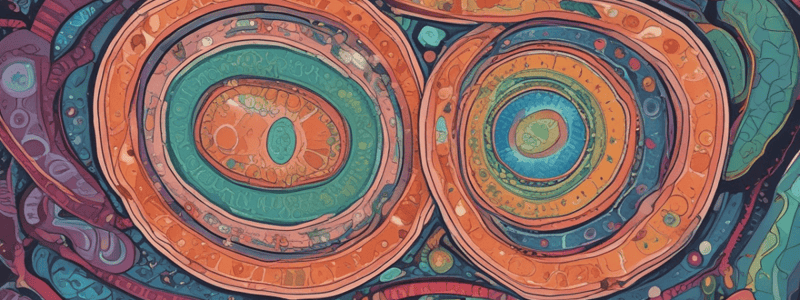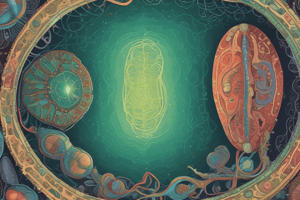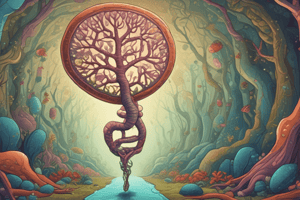Podcast
Questions and Answers
What is the main function of mitochondria?
What is the main function of mitochondria?
- Fatty acid synthesis
- Protein synthesis
- Cell signaling
- Oxidative phosphorylation (correct)
How many base pairs make up the human mitochondrial DNA (mtDNA)?
How many base pairs make up the human mitochondrial DNA (mtDNA)?
- 20,000 bp
- 30,000 bp
- 17,000 bp (correct)
- 10,000 bp
What is the primary location where most mitochondrial proteins are encoded?
What is the primary location where most mitochondrial proteins are encoded?
- Nuclear DNA (correct)
- Cytoplasmic DNA
- Chloroplast DNA
- Mitochondrial DNA
What is the range of variation in the size of mitochondrial genomes among different species?
What is the range of variation in the size of mitochondrial genomes among different species?
What is the byproduct of oxygen consumption during ATP synthesis in mitochondria?
What is the byproduct of oxygen consumption during ATP synthesis in mitochondria?
Which of the following is NOT a component of human mitochondrial DNA?
Which of the following is NOT a component of human mitochondrial DNA?
What is the pattern of inheritance of mitochondria and chloroplasts in Angiosperms?
What is the pattern of inheritance of mitochondria and chloroplasts in Angiosperms?
Which of the following is a mechanism responsible for maternal inheritance of mitochondria?
Which of the following is a mechanism responsible for maternal inheritance of mitochondria?
What is the inheritance pattern of mitochondria in Mammals?
What is the inheritance pattern of mitochondria in Mammals?
In Chlamydomonas, which mating type passes on its mitochondria to the offspring?
In Chlamydomonas, which mating type passes on its mitochondria to the offspring?
What is the fate of sperm mitochondrial DNA during sperm maturation in Drosophila?
What is the fate of sperm mitochondrial DNA during sperm maturation in Drosophila?
In Gymnosperms, which parent contributes mitochondria and chloroplasts to the offspring?
In Gymnosperms, which parent contributes mitochondria and chloroplasts to the offspring?
What happens to paternal mitochondria that enter the egg during fertilization?
What happens to paternal mitochondria that enter the egg during fertilization?
How is human mtDNA transmitted to offspring?
How is human mtDNA transmitted to offspring?
Why do mitochondrial DNA mutations not typically affect the offspring in animals?
Why do mitochondrial DNA mutations not typically affect the offspring in animals?
Which of the following is NOT a mechanism of maternal inheritance of mitochondria?
Which of the following is NOT a mechanism of maternal inheritance of mitochondria?
Why are mitochondria highly susceptible to DNA damage?
Why are mitochondria highly susceptible to DNA damage?
What is a common characteristic of human mitochondrial diseases?
What is a common characteristic of human mitochondrial diseases?
What is heteroplasmy in the context of mitochondrial disease?
What is heteroplasmy in the context of mitochondrial disease?
What is the main goal of the three-parent baby reproductive technology?
What is the main goal of the three-parent baby reproductive technology?
Which of the following is an example of a human mitochondrial disease?
Which of the following is an example of a human mitochondrial disease?
What is the consequence of a high ratio of mutant to normal mitochondria in a cell?
What is the consequence of a high ratio of mutant to normal mitochondria in a cell?
How do mitochondrial mutations accumulate over time?
How do mitochondrial mutations accumulate over time?
What is the resulting pattern of inheritance for human mitochondrial diseases?
What is the resulting pattern of inheritance for human mitochondrial diseases?
Flashcards
Ubiquitin
Ubiquitin
A small regulatory protein that targets organelle destruction, specifically breaking down paternal mitochondria that enter the egg.
Destruction of Sperm Mitochondria
Destruction of Sperm Mitochondria
The process by which paternal mitochondria entering the egg are eliminated.
Maternal Inheritance of Mitochondria
Maternal Inheritance of Mitochondria
The transmission of human mitochondrial DNA (mtDNA) solely from the mother to offspring.
Human Mitochondrial Diseases
Human Mitochondrial Diseases
Signup and view all the flashcards
Heteroplasmy
Heteroplasmy
Signup and view all the flashcards
Threshold Value
Threshold Value
Signup and view all the flashcards
Three-Parent Babies
Three-Parent Babies
Signup and view all the flashcards
Lack of Entry of Sperm Mitochondria
Lack of Entry of Sperm Mitochondria
Signup and view all the flashcards
Destruction of Sperm mtDNA Prior to Fertilization
Destruction of Sperm mtDNA Prior to Fertilization
Signup and view all the flashcards
Oxidative Phosphorylation
Oxidative Phosphorylation
Signup and view all the flashcards
Mitochondrial DNA (mtDNA)
Mitochondrial DNA (mtDNA)
Signup and view all the flashcards
Nuclear-Encoded Mitochondrial Proteins
Nuclear-Encoded Mitochondrial Proteins
Signup and view all the flashcards
Leber Hereditary Optic Neuropathy
Leber Hereditary Optic Neuropathy
Signup and view all the flashcards
Neurogenic Muscle Weakness
Neurogenic Muscle Weakness
Signup and view all the flashcards
Mitochondrial Myopathy and Maternal Myopathy and Cardiomyopathy
Mitochondrial Myopathy and Maternal Myopathy and Cardiomyopathy
Signup and view all the flashcards
Sizes of Organellar Genomes
Sizes of Organellar Genomes
Signup and view all the flashcards
Small Size of Mitochondrial Genomes in Animals
Small Size of Mitochondrial Genomes in Animals
Signup and view all the flashcards
Intermediate Size of Mitochondrial Genomes in Fungi and Protists
Intermediate Size of Mitochondrial Genomes in Fungi and Protists
Signup and view all the flashcards
Large Size of Mitochondrial Genomes in Plants
Large Size of Mitochondrial Genomes in Plants
Signup and view all the flashcards
Destruction of Sperm Mitochondria After Fertilization
Destruction of Sperm Mitochondria After Fertilization
Signup and view all the flashcards
Mitochondrial Function
Mitochondrial Function
Signup and view all the flashcards
Pioneers of Three-Parent Babies Technology
Pioneers of Three-Parent Babies Technology
Signup and view all the flashcards
Study Notes
Destruction of Sperm Mitochondria After Fertilization
- Paternal mitochondria that enter the egg are modified by ubiquitin, a small regulatory protein that targets organelle destruction
- This process occurs in most mammals, including humans
Maternal Inheritance of Mitochondria
- Human mtDNA is transmitted from the female parent to offspring via the cytoplasm of the egg
- Therefore, the transmission of human mitochondrial diseases follows a strict maternal inheritance pattern
Human Mitochondrial Diseases
- Over 200 human mitochondrial diseases have been identified
- These diseases are typically chronic degenerative disorders affecting cells requiring high levels of ATP, such as nerve and muscle cells
- Examples of human mitochondrial diseases include:
- Leber hereditary optic neuropathy, caused by mutations in mitochondrial genes encoding respiratory chain proteins
- Neurogenic muscle weakness, caused by mutations in the ATPase6 gene
- Mitochondrial myopathy and maternal myopathy and cardiomyopathy, caused by mutations in genes encoding tRNA for leucine
Heteroplasmy in Mitochondrial Disease
- Heteroplasmy is an important factor in mitochondrial disease, where cells can contain a mixed population of mitochondria, some with disease-causing mutations and others without
- The ratio of mutant to normal mitochondria can exceed a threshold value, leading to disease symptoms that may vary widely within a given family
Three Parent Babies
- A new reproductive technology has emerged to prevent the transmission of mitochondrial diseases from mothers to their offspring
- This technology was pioneered by John Zhang and colleagues in 2016, and involves replacing the mother's mitochondria with those from a donor woman
Mechanisms of Maternal Inheritance
- There are three mechanisms responsible for maternal inheritance of mitochondria:
- Lack of entry of sperm mitochondria into the egg
- Destruction of sperm mitochondrial DNA prior to fertilization
- Destruction of sperm mitochondria after fertilization
Sizes of Organellar Genomes
- The sizes of organellar genomes vary greatly among different species, with a 400-fold variation in the size of mitochondrial genomes
- Mitochondrial genomes are fairly small in animals, intermediate in size in fungi and protists, and fairly large in plants
Mitochondrial DNA
- The main function of mitochondria is oxidative phosphorylation, which generates ATP (adenosine triphosphate) for cellular reactions
- Human mitochondrial DNA (mtDNA) consists of only 17,000 bp and includes genes for rRNA, tRNA, and 13 polypeptides involved in oxidative phosphorylation
- Most mitochondrial proteins are encoded by genes in the nucleus and are made in the cytoplasm before being transported into the mitochondria
Studying That Suits You
Use AI to generate personalized quizzes and flashcards to suit your learning preferences.
Related Documents
Description
This quiz covers the process of destruction of sperm mitochondria after fertilization in mammals, including humans, and the role of ubiquitin in this process.



